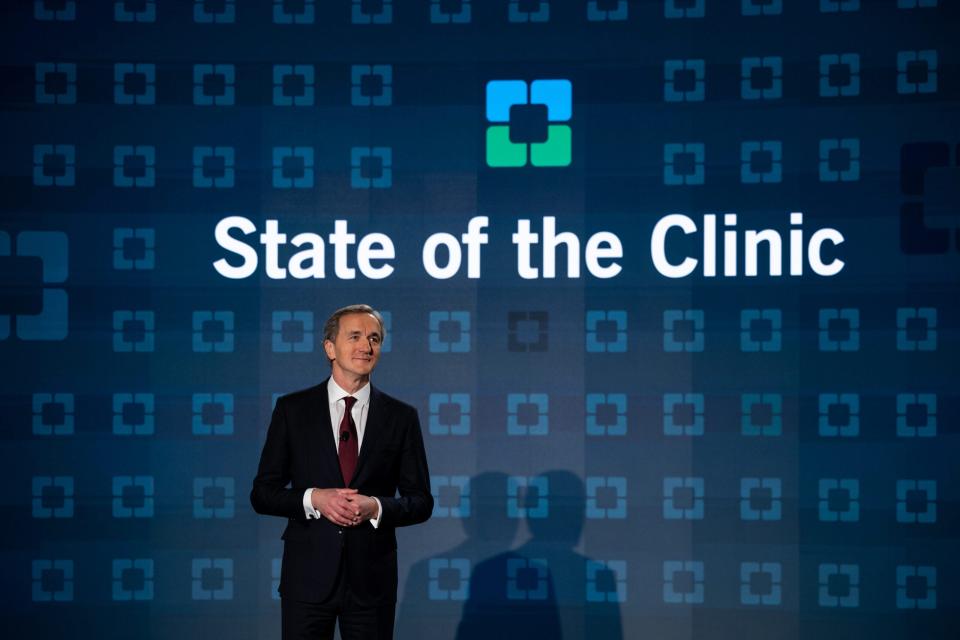Cleveland Clinic expects to lose more than $200 million for 2022, leader says
The Cleveland Clinic is expecting to post more than $200 million in operating losses for 2022 as it emerges from the COVID-19 pandemic, its leader said.
Last year, more than half of hospitals lost money despite patient demand, Cleveland Clinic CEO and President Dr. Tom Mihaljevic said Wednesday morning during his annual State of the Clinic address.
The losses are being driven by health care services pausing during the pandemic, labor shortages and associated higher wages, and inflation effecting supply and pharmaceutical costs, Mihaljevic said.

“I have full trust that we will come out of these times even stronger,” Mihaljevic said during his virtual address.
“We have been able to fulfill our mission for more than 100 years – despite wars, recessions, pandemics and the tragic fire of 1929 on our campus,” he said. “Cleveland Clinic is persistent in good times and in hard times. We stay true to our goals, even when it is most difficult, and have never compromised our care.”
The Cleveland-based health system has 72,500 employees worldwide in 22 hospitals and more than 220 outpatient facilities, including locations in Northeast Ohio; southeast Florida; Las Vegas; Toronto; Abu Dhabi, UAE- United Arab Emirates; and London.
Locally, the Clinic operates Akron General, Medina Hospital, Mercy Hospital in Canton and Union Hospital in Dover.
A Cleveland Clinic spokesperson said the health system does not break out financials for individual properties.
"Like other health systems across the country, we continue to face financial challenges," the spokesperson said in a prepared statement. "While demand for patient care is strong, we are experiencing high costs for supplies, pharmaceuticals and contracted workers. Our organization remains strong and our history of financial stewardship puts us in a solid position to face these challenges.
"We are working to reduce costs and carefully manage our resources."
More:'Food is essential': Cleveland Clinic Akron General opens food pantry for patients in need
Progressing from COVID
Mihaljevic outlined challenges that the health care industry continues to face as the world moves beyond the COVID-19 pandemic.
“In recent years, when I reviewed our accomplishments, we were gripped by winter surges of COVID-19,” he said. “It is comforting to begin the New Year on a healthier footing.”
Mihaljevic said there are several trends causing disruption throughout health care, including:
Americans’ health and patient experience are declining.
More health care workers are burned out, retiring early or leaving their careers.
The majority of hospitals are dealing with financial losses.
Gaps in health care equity threaten to grow wider in local communities.
“Today’s challenges are tomorrow’s opportunities to lead,” he said.
The pandemic strained health care workers worldwide, leading to burnout and early retirement and a global shortage of nearly 2 million healthcare workers, he said.
The Cleveland Clinic has been providing competitive benefit packages and adding incentives, such as bonuses for nurse referrals.
In 2022, Cleveland Clinic hired more than 1,600 new caregivers who live in Cleveland, the most ever in a single year.
More:‘We have to earn trust’: How Akron General is closing the city’s health disparity gap
Investing in the community
Mihaljevic said the Cleveland Clinic continues to reinforce its commitment to the communities it serves by healing, hiring and investing locally.
The health care system continues to invest in research - reinvesting $450 million dollars into research and education. It also contributed more than $50 million to remove lead paint from Cleveland homes.
“We are coming closer to addressing the root causes of unequal health,” Mihaljevic said. “When caring for a healthy community, medical care only contributes to a small portion. There are other factors, such as employment, environment, education and personal behaviors.”
Throughout Cuyahoga County, the hospital’s Center for Infant and Maternal Care is working to ensure that African-American babies and their mothers have an equal chance at healthy lives. The organization also is partnering with others to address access to food.
“We now know that 50,000 children in Cleveland need regular access to nutritious food. The need extends to our Florida communities, including Martin, St. Lucie and Indian River counties,” Mihaljevic said. “Cleveland Clinic is committed to eradicating child hunger for the communities we serve, in partnership with other organizations.”
At Cleveland Clinic Akron General, a food pantry that opened in June of last year has been helping patients of the hospital's Center for Family Medicine who are experiencing food insecurity. The pantry distributed 5,000 items to 786 individuals in 293 households from June 27 to Dec. 9, a spokeswoman said.
Akron General also started a program last year, the ICARE program, which stands for Integrating Clinical and Resource Evaluations. The program is designed to help close health disparity gaps in the neighborhoods around the hospital and helps at-risk patients navigate the health system. It is funded through donations to Akron General and is part of a larger campaign called Neighbor to Neighbor, which was launched in 2020 by Akron General President Brian Harte to specifically address health disparities in Summit County.
Beacon Journal staff reporter Betty Lin-Fisher can be reached at 330-996-3724 or blinfisher@thebeaconjournal.com.
This article originally appeared on Akron Beacon Journal: Cleveland Clinic expected to lose more than $200 million for 2022, leader says

